 Facebook
Facebook
 X
X
 Instagram
Instagram
 TikTok
TikTok
 Youtube
Youtube
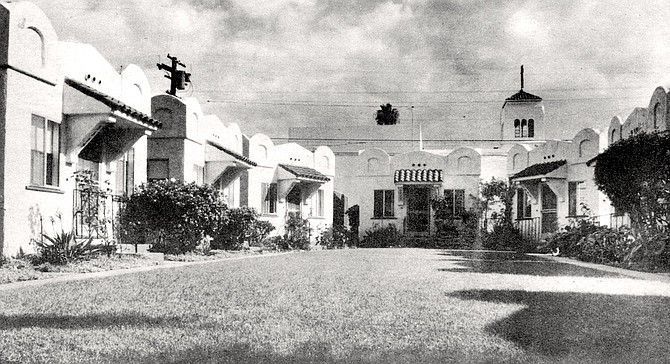
Ron Wigginton, a young landscape designer who leads a well-ordered life, was out roaming the streets of Hillcrest one day four years ago, suddenly on the lookout for a place to live. His rent on Park Boulevard had just gone up from $165 to $205 per month, which was too much for what he called “a box within a crackerbox.” The only thing he’d liked about the building was its big pepper tree, and the property owner had recently torn it out.
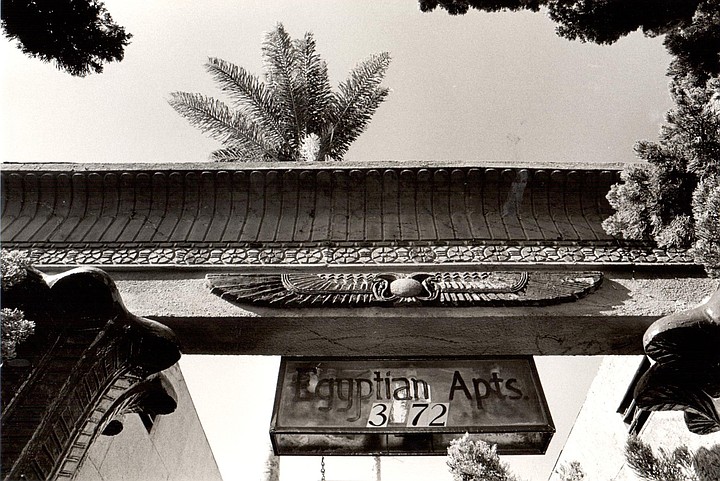
He didn’t know what he was looking for, exactly. Something cheap and nice. He had an eye for building design (his great-grandfather had been a contractor/architect in Oakland), and in two visits to Japan he’d acquired a fondness for compact, subtle landscaping.
One block east of the Highway 163 overpass, on Robinson Avenue in the midst of flat-faced apartment buildings of two and three stories, he saw it — halt — the place he wanted: an arrangement of small, white, Spanish bungalows enclosing an abundantly landscaped court. He walked into the court for a closer look.
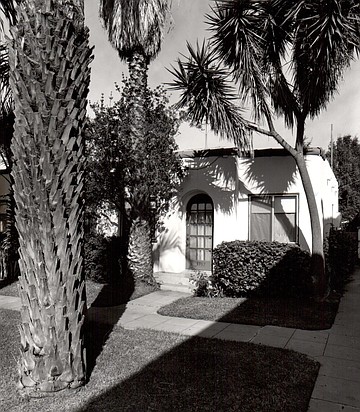
There were six single bungalows facing the central walk, three on each side, and a two-story building at the back. Each building stood alone, distinct, like an egg in a carton, and each had many of the features of a full-size house: flowerbeds, front steps, a porch with a wrought-iron porch lamp, and a corbeled awning over the door. And around back, each had a tiny porch with a door buzzer — the tradesman’s entrance, in miniature. It was like a transistorized neighborhood, this collection of houselets on a earless street.
Wigginton noticed a man tending plants in the courtyard, who turned out to be the owner, Allen Yewchan, a retired city gardener. They got to talking and hit it off — luckily for Wigginton, since there was a waiting list for tenants. The rental on a one-bedroom was $200 a month, which was more than he wanted to spend, but a bargain for what he felt he was getting — excellence at last. He took the apartment, and after four years he moved over to a two-bedroom bungalow by the entrance of the courtyard, needing more space for his business office. He feels that his surroundings speak well for his profession. Lots of people like their apartment, but how many can face their abode in the morning with a feeling of respect? “I look at the buildings, the landscaping, the details,” he said, ‘‘and I think, ‘It couldn’t have been done any better.’ ”

Many good examples of the bungalow court exist in Hillcrest, North Park, and Ocean Beach, neighborhoods that were known as ‘‘trolley suburbs” at the turn of the century, when twenty-five rail lines converged on the central city. The typical court consists of eight to twelve dwellings set in a U-shape about the perimeter of a rectangular lot, with a landscaped yard in the center. In most, the dwellings are singular, but in others they are joined in diptychs. Some courts have garages in back, some don’t. Some look fresher than an ice cube, some are open-air tenements.
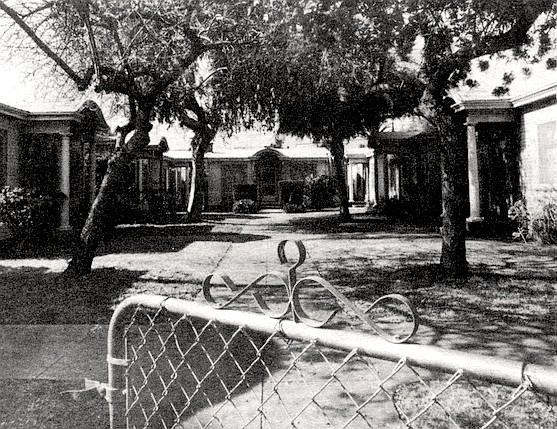
And all of them are appealing, to me, because unlike other forms of apartments, in the bungalow court you can see your place in a glance, all of it, yours, and the effect is akin to owning a set of rooms instead of only occupying them.
The Guide to Architecture in Los Angeles and Southern California lists a bungalow court in North Park. It is at 3933 Hamilton Street, a few doors north of university Avenue, and is in the Pueblo style, with exposed ceiling joists, and parapets, and arbors about the doorways made of fake logs. Too bad this property is such a mess, unpainted and run to seed; it’s the only court listed in the Guide's appreciation of San Diego. The American Institute of Architect’s AIA Guide to San Diego lists no bungalow courts at all.
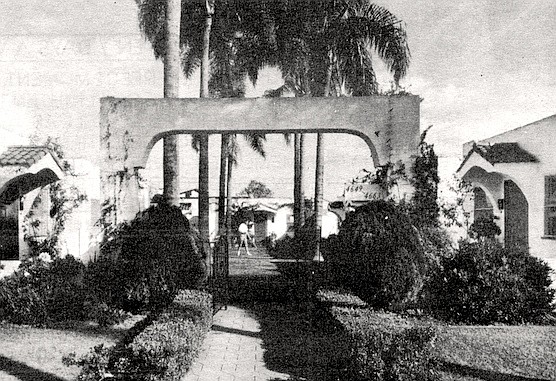
But as an architectural form, the bungalow court is no more noteworthy in San Diego than a barrack. This is because it was established elsewhere and came here purely as a moneymaker, a project any architect could twiddle to suit. Yewchan’s prize court in Hillcrest, where Wigginton lives, was the first and only building project of Winfield E. Randall, who had been in the business of soliciting laundry, and who, his wife said, “had tired of going out and meeting the public.’’ He wanted a property that would provide him and his wife with shelter, income, employment, and some privacy. So he hired a foreman, Olaf Norsven, who in turn hired the architect and workmen. Beginning in May of 1933, they demolished the old house on the lot and uprooted a large pepper tree. “People thought it was ridiculous to start up with a building when the Depression was rock bottom,” said Mrs. Randall on the phone from her home in Allied Gardens. “But I guess my husband knew what he was doing. Anyway, he didn’t care what other people said; he just wanted a place for us to live.”
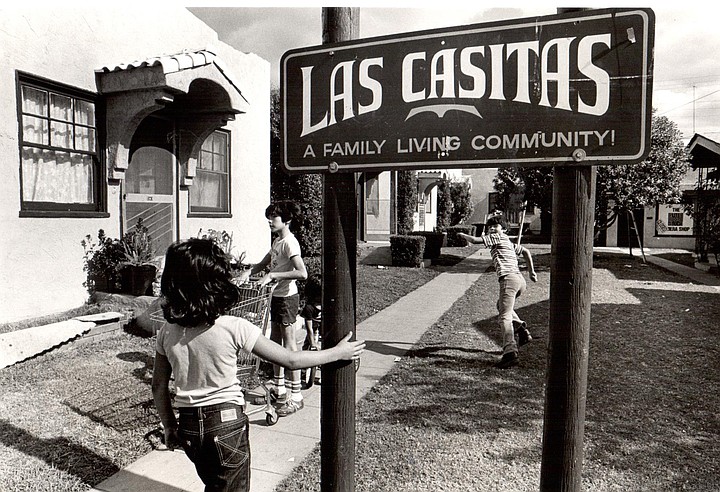
On August 15 the construction was finished and the Randalls moved into their bungalow, which is the first on the left as you enter the front gate. They lived in it for forty years. The other bungalows rented for thirty-five dollars per month, furnished. (In those days, “furnished” meant the provision of bedding, linens, silverware, and kitchen utensils.) Mrs. Randall does not recall what the buildings cost, but the mortgage on the land was one hundred dollars per month. Thus by renting three units, they recovered their land costs, and with four units left to cover the rest of the expenses, they did not go broke.
The apartments attracted young couples and single professional people: a dentist, a doctor, a Marine and his wife were the first who came to rent. “One woman was there about thirty-five years, I heard,” said Mrs. Randall, in a tone of faint surprise. “I guess she liked it.”
In the court, the Randalls planted pencil cypress, low boxwood hedges, and grass lawns. For color there were flowers and two hibiscuses: a Double Pink, and a San Diego Red. They also installed curbs at the edges of the lawns to keep the devil grass out of the beds. Mr. Randall dug the trenches and built the forms, and Mrs. Randall mixed the cement. “In landscaping, we call those curbs ‘mow strips,’” said Wigginton one morning in his bungalow, the one the Randalls lived in for so long. “They give a lawn a clean edge, a place to run by with a trimmer. You see them in institutions and in public places, and believe me they’re an extra. They cost seven dollars a linear foot. Unheard of in an apartment building, yet here they are.”
With an hour to spend before a client arrived, Wigginton led me on a tour of his place, inside and out. He was the perfect host to show the bungalow; because he lives so simply, there was nothing else to show. “I had them take a lot of the furniture out,” he said, looking at his polished dresser. “It’s very good furniture, but I just didn’t need it.” He pointed out that the window casings and closet doors are made of some cheap material, probably pine, but that the workmen had meticulously stained it to resemble expensive grain. The casings and ceiling timbers looked strong against the white walls. “No telling how many layers of plaster they laid on here,” he said, touching a wall with his flat hand, the way you’d touch a warm rock. He said, ‘‘You know, this place was built in the Depression, and you get the feeling that the people hadn’t had jobs in a while, because they were in absolutely no rush to finish this one.”
Mrs. Randall had told me that the bathrooms always clinched the deal whenever she showed an apartment. Wigginton’s was done in black and emerald tiles, with a squash-yellow tub and pedestal sink. “The bathroom in every apartment is different,” he said, “colors you can’t imagine. I still have trouble imagining.”
Walking from room to room, here and there opening a door or pointing to a fixture, Wigginton showed the interior to carry on the promise of the outside. It was a full-size house in miniature — we guessed 700 square feet, half the size of a tract house of the same vintage. It had a living room, two bedrooms, a linen cupboard and a bookcase in the hall, a utility room with a vegetable cooler and pantry, a kitchen with a hooded stove, and next to the stove, a metal box that slides in and out of the wall, holding matches. In the dining room was a locker that held a fold-down ironing board, a rack for drying shirts, and a shoe-shine pedestal with a shelf for the polishing kit.
The place was built like the inside of a yacht: maximum convenience, minimum space. This kind of outfitting was characteristic of the bungalow, or the “California bungalow,” as it was often called.
Its ideal was a simple, natural home that valued comfort over show, and its realization attracted some of the country’s best designing talent early in this century. The Greene brothers, Charles and Henry, trained at the Massachusetts Institute of Technology and went to Pasadena in 1893, where they helped to develop the Japo-Swiss style (better looking than it sounds), with its emphasis on wood, strength, and craft. The bungalow was an emblem for healthful living: the great indoors. Architects knew of religious campgrounds in the East and Midwest in which a gathering of humble buildings faced a central plot. Of these two ideas came (or might have come; no one really knows) the bungalow court.
Robert Winter, an historian at Occidental College in Los Angeles, credits the innovation to Sylvanus Marston, an architect who, in May of 1909, submitted plans for eleven dwellings arranged in a court on what was then called Colorado Street, in Pasadena. They were full-size homes for the rich, and as rentals were intended to compete with Pasadena’s luxury hotels, the Huntington, the Raymond, and the Green. Rent was as much as $1200 for the winter season.
Right away, architect Arthur S. Heineman designed several bungalow courts that proved to be popular with the professional class. The Bowen’s Court apartments, which were featured in the November, 1916 issue of House Beautiful, consisted of twenty-three houses on an L-shaped lot with a Japanese pond. The typical house rented for fifty dollars per month, furnished. The renter enjoyed a garden atmosphere and more privacy than was usual in an apartment building; the builder found that a couple of city lots could yield a satisfying number of dwellings indeed. Heineman went on to invent the motel.
By the 1930s, bungalow courts were appearing in a fantastic variety of styles: Tudor, Dutch, French, Moorish, Egyptian (celebrating the discovery of King Tutankhamen’s tomb in 1922), and of course Spanish and Mission. Moreover, they were serving renters of low and moderate means. Charles Greene lamented what he saw being done to the bungalow ideal. “The style and design of each unit is uniform, making for the monotony and dreariness of a factory district,” he wrote. “Added to this, the buildings are hopelessly crowded.”
“They were about the cheapest type of housing available,” said Rob Quigley, a tall, amiable, thirty-seven-year-old architect who works out of Sorrento Valley and who has attempted to use the concept of the bungalow court in some of his recent designs. It’s a good thing that a concept doesn’t cost anything, because given today’s prices of land, labor, materials, and financing, the concept of the bungalow court is all the builder can afford.
“First of all, you just can’t have that many detached units,” Quigley said. “Can’t afford to build all those walls. But you can take the idea of the idealized house, miniaturize it, and work with that. And you can play with the idea of a court, which is what I’ve done the most.”
Designing the Pacifica Townhomes, at Nimitz and West Point Loma boulevards, Quigley decided to make the most of the parking requirements instead of working against them, and made the central courtyard a first-class cul-de-sac, with cool, neon-colored tiles in the pavement and patches of grass that look like outsize manhole covers. The idea was to draw people into their own private street, but it doesn’t work. “I needed a little more ‘transition space,’ ” said Quigley. I was in the courtyard the other day and I would say it needed something more than that to make it enjoyable.
The truth is that most people in a bungalow court don’t use the courtyard anyway, except as a buffer for privacy, so the designer would seem to have more range in thinking of different kinds of buffers, and here I think Quigley has had real success. At 1788 Missouri Street in Pacific Beach he designed a two-building, four-unit condominium with a V-shaped yard in the middle. But instead of grass, the yard is all lilies, and has a narrow boardwalk down the center. It’s pleasant to look at, it separates the buildings, and nobody has to mow it. At night the boardwalk lights up with plastic stars imbedded in the wood — a moonwalk across the property. The landscape designer for this project of Quigley’s — to bring this full circle — was Ron Wigginton.

Wigginton, expecting his client to arrive soon, had time for one more observation about his Hillcrest bungalow. “I’m on the phone to my young niece and nephew a lot in Oregon,” he said, “and I’m always describing this place. I tell them I’m looking out my window, and I see a banana tree loaded with bananas, an orange tree with oranges, a lime tree, and on and on. And they think I live on a plantation. They won’t believe how small it is if they see it. . . . Which shows you how much you can do with buildings and landscaping if you have the opportunity, and take the time, and go at it with a little care.”


Ron Wigginton, a young landscape designer who leads a well-ordered life, was out roaming the streets of Hillcrest one day four years ago, suddenly on the lookout for a place to live. His rent on Park Boulevard had just gone up from $165 to $205 per month, which was too much for what he called “a box within a crackerbox.” The only thing he’d liked about the building was its big pepper tree, and the property owner had recently torn it out.

He didn’t know what he was looking for, exactly. Something cheap and nice. He had an eye for building design (his great-grandfather had been a contractor/architect in Oakland), and in two visits to Japan he’d acquired a fondness for compact, subtle landscaping.
One block east of the Highway 163 overpass, on Robinson Avenue in the midst of flat-faced apartment buildings of two and three stories, he saw it — halt — the place he wanted: an arrangement of small, white, Spanish bungalows enclosing an abundantly landscaped court. He walked into the court for a closer look.

There were six single bungalows facing the central walk, three on each side, and a two-story building at the back. Each building stood alone, distinct, like an egg in a carton, and each had many of the features of a full-size house: flowerbeds, front steps, a porch with a wrought-iron porch lamp, and a corbeled awning over the door. And around back, each had a tiny porch with a door buzzer — the tradesman’s entrance, in miniature. It was like a transistorized neighborhood, this collection of houselets on a earless street.
Wigginton noticed a man tending plants in the courtyard, who turned out to be the owner, Allen Yewchan, a retired city gardener. They got to talking and hit it off — luckily for Wigginton, since there was a waiting list for tenants. The rental on a one-bedroom was $200 a month, which was more than he wanted to spend, but a bargain for what he felt he was getting — excellence at last. He took the apartment, and after four years he moved over to a two-bedroom bungalow by the entrance of the courtyard, needing more space for his business office. He feels that his surroundings speak well for his profession. Lots of people like their apartment, but how many can face their abode in the morning with a feeling of respect? “I look at the buildings, the landscaping, the details,” he said, ‘‘and I think, ‘It couldn’t have been done any better.’ ”

Many good examples of the bungalow court exist in Hillcrest, North Park, and Ocean Beach, neighborhoods that were known as ‘‘trolley suburbs” at the turn of the century, when twenty-five rail lines converged on the central city. The typical court consists of eight to twelve dwellings set in a U-shape about the perimeter of a rectangular lot, with a landscaped yard in the center. In most, the dwellings are singular, but in others they are joined in diptychs. Some courts have garages in back, some don’t. Some look fresher than an ice cube, some are open-air tenements.

And all of them are appealing, to me, because unlike other forms of apartments, in the bungalow court you can see your place in a glance, all of it, yours, and the effect is akin to owning a set of rooms instead of only occupying them.
The Guide to Architecture in Los Angeles and Southern California lists a bungalow court in North Park. It is at 3933 Hamilton Street, a few doors north of university Avenue, and is in the Pueblo style, with exposed ceiling joists, and parapets, and arbors about the doorways made of fake logs. Too bad this property is such a mess, unpainted and run to seed; it’s the only court listed in the Guide's appreciation of San Diego. The American Institute of Architect’s AIA Guide to San Diego lists no bungalow courts at all.

But as an architectural form, the bungalow court is no more noteworthy in San Diego than a barrack. This is because it was established elsewhere and came here purely as a moneymaker, a project any architect could twiddle to suit. Yewchan’s prize court in Hillcrest, where Wigginton lives, was the first and only building project of Winfield E. Randall, who had been in the business of soliciting laundry, and who, his wife said, “had tired of going out and meeting the public.’’ He wanted a property that would provide him and his wife with shelter, income, employment, and some privacy. So he hired a foreman, Olaf Norsven, who in turn hired the architect and workmen. Beginning in May of 1933, they demolished the old house on the lot and uprooted a large pepper tree. “People thought it was ridiculous to start up with a building when the Depression was rock bottom,” said Mrs. Randall on the phone from her home in Allied Gardens. “But I guess my husband knew what he was doing. Anyway, he didn’t care what other people said; he just wanted a place for us to live.”

On August 15 the construction was finished and the Randalls moved into their bungalow, which is the first on the left as you enter the front gate. They lived in it for forty years. The other bungalows rented for thirty-five dollars per month, furnished. (In those days, “furnished” meant the provision of bedding, linens, silverware, and kitchen utensils.) Mrs. Randall does not recall what the buildings cost, but the mortgage on the land was one hundred dollars per month. Thus by renting three units, they recovered their land costs, and with four units left to cover the rest of the expenses, they did not go broke.
The apartments attracted young couples and single professional people: a dentist, a doctor, a Marine and his wife were the first who came to rent. “One woman was there about thirty-five years, I heard,” said Mrs. Randall, in a tone of faint surprise. “I guess she liked it.”
In the court, the Randalls planted pencil cypress, low boxwood hedges, and grass lawns. For color there were flowers and two hibiscuses: a Double Pink, and a San Diego Red. They also installed curbs at the edges of the lawns to keep the devil grass out of the beds. Mr. Randall dug the trenches and built the forms, and Mrs. Randall mixed the cement. “In landscaping, we call those curbs ‘mow strips,’” said Wigginton one morning in his bungalow, the one the Randalls lived in for so long. “They give a lawn a clean edge, a place to run by with a trimmer. You see them in institutions and in public places, and believe me they’re an extra. They cost seven dollars a linear foot. Unheard of in an apartment building, yet here they are.”
With an hour to spend before a client arrived, Wigginton led me on a tour of his place, inside and out. He was the perfect host to show the bungalow; because he lives so simply, there was nothing else to show. “I had them take a lot of the furniture out,” he said, looking at his polished dresser. “It’s very good furniture, but I just didn’t need it.” He pointed out that the window casings and closet doors are made of some cheap material, probably pine, but that the workmen had meticulously stained it to resemble expensive grain. The casings and ceiling timbers looked strong against the white walls. “No telling how many layers of plaster they laid on here,” he said, touching a wall with his flat hand, the way you’d touch a warm rock. He said, ‘‘You know, this place was built in the Depression, and you get the feeling that the people hadn’t had jobs in a while, because they were in absolutely no rush to finish this one.”
Mrs. Randall had told me that the bathrooms always clinched the deal whenever she showed an apartment. Wigginton’s was done in black and emerald tiles, with a squash-yellow tub and pedestal sink. “The bathroom in every apartment is different,” he said, “colors you can’t imagine. I still have trouble imagining.”
Walking from room to room, here and there opening a door or pointing to a fixture, Wigginton showed the interior to carry on the promise of the outside. It was a full-size house in miniature — we guessed 700 square feet, half the size of a tract house of the same vintage. It had a living room, two bedrooms, a linen cupboard and a bookcase in the hall, a utility room with a vegetable cooler and pantry, a kitchen with a hooded stove, and next to the stove, a metal box that slides in and out of the wall, holding matches. In the dining room was a locker that held a fold-down ironing board, a rack for drying shirts, and a shoe-shine pedestal with a shelf for the polishing kit.
The place was built like the inside of a yacht: maximum convenience, minimum space. This kind of outfitting was characteristic of the bungalow, or the “California bungalow,” as it was often called.
Its ideal was a simple, natural home that valued comfort over show, and its realization attracted some of the country’s best designing talent early in this century. The Greene brothers, Charles and Henry, trained at the Massachusetts Institute of Technology and went to Pasadena in 1893, where they helped to develop the Japo-Swiss style (better looking than it sounds), with its emphasis on wood, strength, and craft. The bungalow was an emblem for healthful living: the great indoors. Architects knew of religious campgrounds in the East and Midwest in which a gathering of humble buildings faced a central plot. Of these two ideas came (or might have come; no one really knows) the bungalow court.
Robert Winter, an historian at Occidental College in Los Angeles, credits the innovation to Sylvanus Marston, an architect who, in May of 1909, submitted plans for eleven dwellings arranged in a court on what was then called Colorado Street, in Pasadena. They were full-size homes for the rich, and as rentals were intended to compete with Pasadena’s luxury hotels, the Huntington, the Raymond, and the Green. Rent was as much as $1200 for the winter season.
Right away, architect Arthur S. Heineman designed several bungalow courts that proved to be popular with the professional class. The Bowen’s Court apartments, which were featured in the November, 1916 issue of House Beautiful, consisted of twenty-three houses on an L-shaped lot with a Japanese pond. The typical house rented for fifty dollars per month, furnished. The renter enjoyed a garden atmosphere and more privacy than was usual in an apartment building; the builder found that a couple of city lots could yield a satisfying number of dwellings indeed. Heineman went on to invent the motel.
By the 1930s, bungalow courts were appearing in a fantastic variety of styles: Tudor, Dutch, French, Moorish, Egyptian (celebrating the discovery of King Tutankhamen’s tomb in 1922), and of course Spanish and Mission. Moreover, they were serving renters of low and moderate means. Charles Greene lamented what he saw being done to the bungalow ideal. “The style and design of each unit is uniform, making for the monotony and dreariness of a factory district,” he wrote. “Added to this, the buildings are hopelessly crowded.”
“They were about the cheapest type of housing available,” said Rob Quigley, a tall, amiable, thirty-seven-year-old architect who works out of Sorrento Valley and who has attempted to use the concept of the bungalow court in some of his recent designs. It’s a good thing that a concept doesn’t cost anything, because given today’s prices of land, labor, materials, and financing, the concept of the bungalow court is all the builder can afford.
“First of all, you just can’t have that many detached units,” Quigley said. “Can’t afford to build all those walls. But you can take the idea of the idealized house, miniaturize it, and work with that. And you can play with the idea of a court, which is what I’ve done the most.”
Designing the Pacifica Townhomes, at Nimitz and West Point Loma boulevards, Quigley decided to make the most of the parking requirements instead of working against them, and made the central courtyard a first-class cul-de-sac, with cool, neon-colored tiles in the pavement and patches of grass that look like outsize manhole covers. The idea was to draw people into their own private street, but it doesn’t work. “I needed a little more ‘transition space,’ ” said Quigley. I was in the courtyard the other day and I would say it needed something more than that to make it enjoyable.
The truth is that most people in a bungalow court don’t use the courtyard anyway, except as a buffer for privacy, so the designer would seem to have more range in thinking of different kinds of buffers, and here I think Quigley has had real success. At 1788 Missouri Street in Pacific Beach he designed a two-building, four-unit condominium with a V-shaped yard in the middle. But instead of grass, the yard is all lilies, and has a narrow boardwalk down the center. It’s pleasant to look at, it separates the buildings, and nobody has to mow it. At night the boardwalk lights up with plastic stars imbedded in the wood — a moonwalk across the property. The landscape designer for this project of Quigley’s — to bring this full circle — was Ron Wigginton.

Wigginton, expecting his client to arrive soon, had time for one more observation about his Hillcrest bungalow. “I’m on the phone to my young niece and nephew a lot in Oregon,” he said, “and I’m always describing this place. I tell them I’m looking out my window, and I see a banana tree loaded with bananas, an orange tree with oranges, a lime tree, and on and on. And they think I live on a plantation. They won’t believe how small it is if they see it. . . . Which shows you how much you can do with buildings and landscaping if you have the opportunity, and take the time, and go at it with a little care.”
Comments